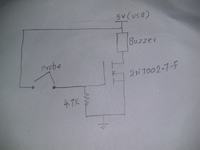sathiyanarayananL
Newbie level 6
Hi guys,
Im trying to make a continuity tester as an alternate for multimeter continuity tester. Im facing a issue, that it shows a short circuit in all conditions. The schematics for the tester have been attached.
i have powered the circuit from USB ( +5V ). Is my circuit correct?
Im trying to make a continuity tester as an alternate for multimeter continuity tester. Im facing a issue, that it shows a short circuit in all conditions. The schematics for the tester have been attached.
i have powered the circuit from USB ( +5V ). Is my circuit correct?
